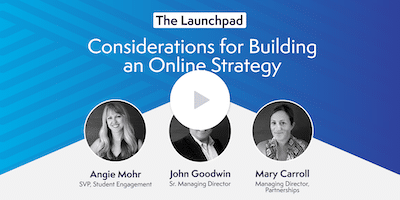Strategies for Increasing Student Enrollment
The traditional paradigms of higher education enrollment have shifted, driven by technological advancements and changing student demographics. The industry is undergoing not just surface-level adjustments that require minor alterations to enrollment strategies, but rather a deeper evolution that reimagines the very fabric of educational delivery and consumption.
As senior director of admissions at Archer Education, I’ve seen firsthand that today’s learners demand more than just a degree; they seek a flexible, engaging, and relevant educational experience that aligns with their personal and professional goals.
Many institutions aren’t doing enough to meet those demands, and prospective students can sniff them out. But for institutions that are truly student-focused — and capable of communicating that through their marketing efforts — significant enrollment gains are possible. Let’s take a look at:
- Who today’s students are, and what they want
- Enrollment strategies that cater to modern learners
- How to speak to prospective students through marketing
Evolving Educational Models and Students’ Needs
As we push through 2024 and beyond, it’s no secret that online learners are a critical market for institutions to capture. But not all online programs are created equal. Online students are looking for particular benefits, and the institutions that offer those benefits will be the ones to reap enrollment wins.
Emerging Trends in Online and Hybrid Learning
The demand for online and hybrid learning models continues to grow, as indicated by recent reports and surveys. A 2023 CHLOE 8 Report highlights a significant increase in demand for online and hybrid learning opportunities, with a notable shift away from traditional in-person courses and programs.
The report reveals that 57% of chief online officers (COOs) have seen stagnant enrollments in traditional undergraduate in-person programs, with 24% reporting declining numbers. Conversely, COOs have seen growth or strong growth in fully online and hybrid program enrollments, with 36% reporting increases in online program enrollments and 20% in hybrid program enrollments.
Synchronous vs. Asynchronous Learning
While many colleges and universities seek to hold fast to the tradition of synchronous learning, from an enrollment perspective, this strategy can be unwise.
Asynchronous learning, without the constraints of scheduled class times, is appealing to working adults and those with unpredictable schedules. It allows students to learn at their own pace, fitting education into their busy lives rather than the other way around.
Students’ Expectations and Preferences
Modern students prioritize flexibility and convenience, largely due to their digital fluency. They expect educational offerings to be accessible, engaging, and relevant to their specific career aspirations. If students aren’t convinced that your degree offering will help them advance, they aren’t going to enroll.
Additionally, the importance of career services and robust support systems in online learning environments cannot be overstated. Students look for programs that not only educate them but also help facilitate their success after graduation.
Enrollment Strategies for Modern Students
In many ways, higher education is defined by tradition. And while celebrating an institution’s history is important, higher education as a whole must adapt to consumers’ needs — just like any other industry. Here are four key strategies for increasing student enrollment in 2024:
1. Consistent Branding Across Platforms
Your institution has a brand: just like Nike, Apple, and Cadillac. The best brands adhere to a unified, consistent message, and your institution should strive to do the same.
Communicating Value and Career Pathways
Effective enrollment strategies begin with clear and consistent messaging about outcomes. Your institution should articulate the value of its educational offerings and how they lead to career advancement.
Highlighting success stories and clear career pathways can help prospective students visualize their future after completing their studies. This approach reassures students that their investment in education will pay off in terms of career opportunities and advancement.
Building a Transfer-Friendly Environment
To appeal to a broader range of students, including those looking to transfer from community colleges or other institutions, your university should promote its transfer credit policies and accelerated programs.
A transparent and straightforward transfer process, coupled with the recognition of prior learning, can reduce both the cost and time it takes to earn a degree, making higher education more accessible and attractive to today’s students.
Providing Community and Support Resources
Creating a sense of belonging and community is crucial, especially for students in online programs who might feel isolated. Your institution can foster this sense of community through direct communication channels with faculty and opportunities for peer interactions, such as online forums and virtual study groups. Providing robust support resources, including academic advising, tutoring, and mental health services, can further enhance the experience for students and contribute to retention.
2. Effective Online Advertising
Where might you meet digital learners in the digital age? You guessed it. Through digital advertising. Here are some tips for using the medium to its fullest potential:
Using Targeted Advertising Strategies
Reaching your audience requires much more than boosting posts on your institution’s Facebook page. You need to identify the most impactful platforms and ad formats to reach your target audience.
You also must leverage data analytics to refine your advertising campaigns in ways that will improve your engagement and conversion rates for a better return on your investment. Personalization and segmentation are key, allowing your messages to be tailored to the specific interests and needs of potential students.
Highlighting Unique Selling Points
Your institution must clearly communicate its unique selling points, or unique value propositions (UVPs), to stand out in a crowded market. This could include things such as:
- Specialized programs
- Flexible learning options
- Competitive pricing
- Accelerated paths to degree completion
- Strong career placement records
You have to take the time to understand your institution’s UVPs, then tailor your messaging to align with the goals and values of your prospective students, emphasizing how the institution’s offerings match their personal and professional aspirations.
3. Strong Employer Partnerships
The employer-university relationship is a two-way street: Both sides need each other to enroll students and build a skilled workforce. With this in mind, your institution should align its goals with the employment market and communicate that effort to students.
Developing Employment-Focused Curricula and Marketing Assets
Collaboration between educational institutions and employers is becoming increasingly vital in shaping curricula that meet current market demands. These partnerships can significantly enhance the relevance and appeal of educational programs, ensuring that they provide students with the skills and knowledge employers seek.
By integrating real-world insights and potential job opportunities into its curricula and marketing strategies, your institution can attract students who are focused on their immediate career outcomes after graduation.
Speaking to Tuition Reimbursement and Career Advancement
Highlighting opportunities for tuition reimbursement through employer partnerships can be a strong draw for prospective students. Many companies offer educational benefits as part of their employment packages, and institutions that can guide students on leveraging these benefits to help pay for their studies stand out.
Emphasizing the direct link between education and career advancement in your enrollment messages can showcase your institution’s commitment to the professional growth of its students.
4. Fast Admission and Enrollment Processes
In the world of instant gratification, it’s no longer acceptable for institutions to mull over enrollment decisions for weeks, or even months. Ideally, an admissions decision will be made and communicated to the student within 24 hours.
Simplifying the Enrollment Process
The speed and simplicity of the admissions process can significantly impact a prospective student’s decision to enroll. Simplifying your application requirements and providing prospective students with clear, concise information about your program options, costs, and financial aid opportunities can make the process less daunting and more appealing to them. Ask yourself these questions:
- What are the current pain points of our admissions process?
- How can we make our application requirements clearer (and less intensive)?
- Can we reduce the number of steps in our application process?
- How accessible is our application portal?
- Are there opportunities to automate parts of our admissions process?
Implementing Efficient Admissions Strategies
Adopting tools and strategies that facilitate a smooth admissions journey is crucial. This can include offering customized digital experiences for students, such as those available through our Onward tool, using artificial intelligence for preliminary assessments, and providing virtual advising sessions to quickly address applicants’ questions. Implementing efficient admissions strategies will not only enhance the experience for prospective students but also demonstrate your institution’s dedication to innovation and student support.
Let Us Help You Streamline Your Institution’s Enrollment Strategies
Here at Archer Education, we partner with colleges and universities to build sustainable online growth. We provide organizational development, marketing, enrollment, and retention support for the entire student journey, helping institutions revolutionize their enrollment strategies to attract and retain high-quality students. If you’re interested in learning more, click here to contact our team!



